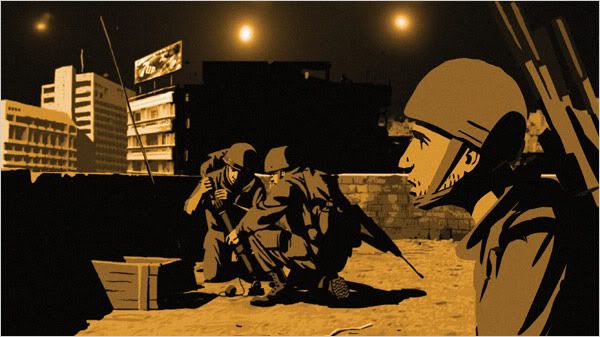 |
| Fig. 1 Waltz with Bashir poster. |
Ari Folman's Waltz with Bashir is
a fantastic and innovative way to portray a documentary film. From
start to finish it grabs the audience by the throat and pulls them
into a film covering some serious subject matter. The narrative that
runs through this documentary is the need for the lead character, Ari
Folman; who is also the writer and director of the film, to discover
his past.
Before talking about the stunning art
style and the innovative portrayal of a documentary, it is important
to understand the context of this particular documentary. This film
reveals a part of Israel's history that the country itself has
struggled with. Waltz with Bashir is the first film to emerge from
the country since the 60's and why they allowed it to be an animation
is very intriguing, Perhaps due to the idea that animation is not
taken as seriously as a traditional live action film is. It is only a
cartoon so it can not be portraying real and serious issues. No
matter what the reasoning, it allowed Folman to touch on some
particularly important and shocking events in his and his fellow
country men's lives. All of it stems from when Israeli military
invaded Lebanon in 1982. The country was suffering from violent
civil unrest and the current president "Bachir
Gemayel” was believed to have been assassinated by Palestinian
militants. This lead to a series of horrific murders by the
"Lebanese
Christian Phalangist
militia, in the Sabra
and Shatila
Palestinian
refugee
camps in Beirut,
Lebanon”.
Ari Folman was part of the armed forces that were involved in
 |
| Fig. 2 Soldiers firing flares. |
Though the massacres are horrific, and
something that could easily be represented with damning violence in a
film, Waltz with Bashir instead focuses on a much more personal
expression of the events. As writer, Alice Rothchild, expressed,
that "Waltz
with Bashir, by
Ari Folman, explored an Israeli soldier’s search for his lost
memories regarding his participation in the brutal massacres in Sabra
and Shatilla, both damning the IDF and exposing us to the trauma that
young soldiers experience fighting Israel’s wars."
(Rothchild, 2010:261) Though the events displayed in the film are
clearly distressing and horrendous acts of violence by a dominant and
aggressive outside force, the audience is not being lead to only
experience how awful the perpetrators are but how these actions
effect those involved. For example, the audience follows around Ari
Folman as a young soldier. As a matured man, he recollects his
actions gradually as he discovers new memories. As film reviewer, Dan
Jolin explains, "Here we see warfare not just on the sensory level but also on the subconscious: recollection, fever-dream and immediate experience all at once" (Jolin, 2008) The
audience is welcomed into Folman's new world of memories first
through a lucid vision that seems more like a dream than something
that could have actually occurred. His body has prevented him from
fully remembering his involvement in the massacre for over 20 years,
now, as he pushes towards away at it, cracks start to appear,
revealing memories he never knew he had. These memories are
gradually more realistically portrayed as the film goes on,
representing the writer's clarity of mind as he interviews more and
more people involved in Beirut that day.
 |
| Fig. 3 Graphic novel style. |
Ari Folman was discovering a huge and
possibly devastating part of his and his country's past. To
successfully represent this visuals is extremely important. As
writer, Bill Nichols, believes: “The
event haunts him for years afterwards and the animated images give
graphic representation to the agony, isolation, and despair that he,
and others, subsequently felt."(Nichols, 2010:111) This
can be seen as showing Folman's complete success in getting across
the documentary's tone and atmosphere to match the content. To
represent these events in an animated style is very difficult as it
would need to be as bold and powerful as the subject it is showing.
Waltz with Bashir is a prime example of when style succeeds to
match the heavy message it is trying to portray. Visually, its
heavily inked graphic novel style makes it an incredibly modern take
on the very typical documentary genre. Nichols went on to EXPLAIN
that the animation style "clearly
possess[es] a strongly subjective, even expressionistic, quality.
They attempt to see war as the disoriented, confused Israeli
soldiers, including the filmmaker, saw it...As a representation of
subjective states of mind, the film achieves a high degree of
plausibility even as it departs from any standard sense of
documentary realism." (Nichols, 2010:13-4) Despite the
film's use of a sometimes expressionistic quality as it tries to
visually recreate the soldiers' state of mind, it still manages to
retain the plausibility and power that the realism found in a
traditional documentary would have.
The film is a brave look into the world
of a soldier during that horrible time in Lebanon. It manages to
portray the horror that every day warfare would bring, while
accompanied by the blackest humour the soldiers would have to keep
their spirits up. The final sequence is possibly one of the most
powerful ways the film could have ended and because of that, on top
of the stunning quality of visuals and writing, it deserves every
reward it received.
List of Illustrations
Figure 1. Waltz with Bashir (2008) Waltz with Bashir
poster. At: http://www.impawards.com/intl/misc/2008/waltz_with_bashir.html (Accessed on: 12.03.12)
Figure 2. Waltz with Bashir (2008) Soldiers firing flares. At: http://graphics8.nytimes.com/images/2008/12/26/movies/26bash.xlarge3.jpg (Accessed on: 12.03.12)
Figure 3. Waltz with Bashir (2008) Graphic novel style. At: http://collider.com/uploads/imageGallery/Waltz_with_Bashir/waltz_with_bashir_movie_image__2_.jpg (Accessed on: 12.03.12)
Bibliography
Jolin, Dan (2008) Waltz with Bashir. In:
Empire Online.com 17.11.2008 [online] At:
http://www.empireonline.com/reviews/reviewcomplete.asp?DVDID=118051
(Accessed on: 12.03.12)
Nichols, Bill (2010) Introduction to
Documentary. USA: Indiana University Press.
Rothchild, Alice (2010) Broken Promises, Broken
Dreams : Stories of Jewish and Palestinian Trauma and Resilience.
GBR: Pluto Press


No comments:
Post a Comment